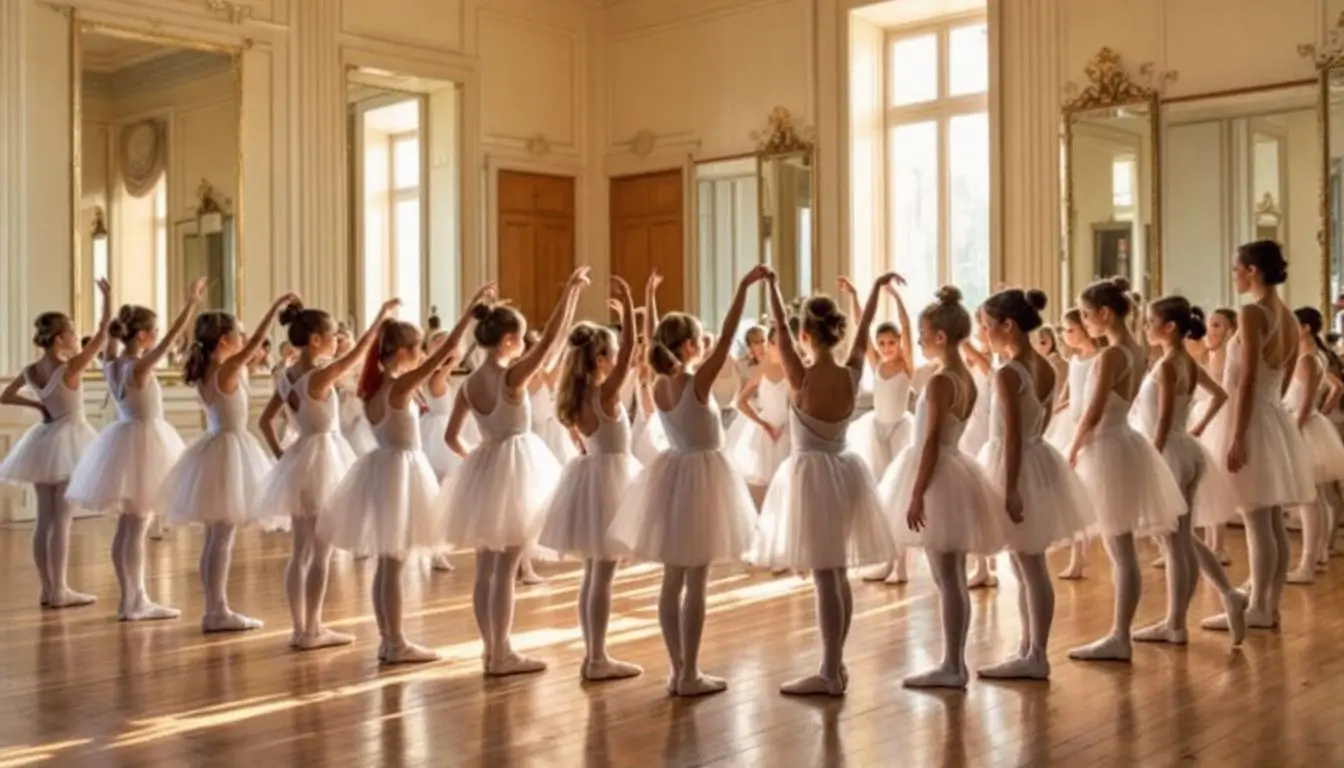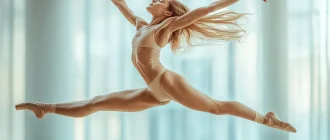Looking for the best ballet schools in Germany that offer exceptional ballet training and are affiliated with professional ballet companies? This guide highlights top institutions, such as the John Cranko School and the Hamburg Ballet School. Learn about their rigorous training programs, admission criteria, and how they prepare students for successful ballet careers.
Key Takeaways
- Germany’s top ballet schools, such as the John Cranko School and Hamburg Ballet School, provide rigorous training combining classical ballet and contemporary techniques. These schools ensure a well-rounded education for aspiring dancers and collaborate with professional ballet companies.
- International students are welcomed in German ballet schools, which integrate diverse cultural perspectives into their curriculum, allowing young dancers to balance academic education with intensive dance training.
- These institutions’ key features include practical performance opportunities and collaboration with professional ballet companies. These enhance students’ stage presence and confidence while preparing them for diverse careers in dance.
Art de Podcast
| # | Ballet School | Location | Key Features | Website |
|---|---|---|---|---|
| 1 | John Cranko School | Stuttgart | Vaganova-based curriculum, professional stage exposure, prize-winning graduates. | john-cranko-schule.de |
| 2 | Hamburg Ballet School | Hamburg | Affiliated with the Hamburg Ballet, it focuses on classical and academic dance and choreography. | hamburgballett.de |
| 3 | Palucca University of Dance Dresden | Dresden | Blend of ballet, contemporary, and improvisation; recognized as a higher education institution. | palucca.eu |
| 4 | Staatliche Ballettschule Berlin | Berlin | Combining ballet training with academic education produces global performance dancers. | ballettschule-berlin.de |
| 5 | Ballet Academy, University of Music Munich | Munich | Vaganova curriculum collaborates with local ballet companies for professional exposure. | hmtm.de |
| 6 | Ballet School of Deutsche Oper am Rhein | Düsseldorf and Duisburg | Linked to Deutsche Oper am Rhein; focuses on professional performance opportunities. | operamrhein.de |
| 7 | Ballet School of Leipzig Opera | Leipzig | Strong collaboration with Leipzig Opera for stage performance and ballet training. | oper-leipzig.de |
| 8 | Ballet School of the Bavarian State Opera | Munich | Offers ballet training and stage experience with the Bavarian State Opera. | staatsoper.de |
| 9 | Ballet School of the Berlin State Opera | Berlin | Provides students with professional performance opportunities through the Berlin State Opera. | staatsoper-berlin.de |
| 10 | Ballet School of Theater Dortmund | Dortmund | Works closely with Theater Dortmund, providing students with stage exposure. However, the regular Open Classes are temporarily suspended. | theaterdo.de |
Germany is a leading nation known for its prestigious schools that blend classical ballet with contemporary dance techniques. These institutions, such as the John Cranko School and the Hamburg Ballet School, offer a comprehensive education that balances rigorous dance training with academic studies, providing a well-rounded experience for young people who aspire to excel in the dance world.
In addition to their robust academic programs, these schools also emphasize ballet training, which prepares students for careers in professional ballet companies.
These schools offer a curriculum that enhances technical skills and artistic expression, setting the stage for future ballet careers. By integrating diverse cultural perspectives into their programs, these schools have become global centers for dance education, especially for international students.
Germany’s Rich Dance History
Germany has a rich and diverse dance history, with a strong tradition of classical ballet dating back to the 18th century. The country has produced some of the world’s most renowned ballet companies and schools, including the Hamburg Ballet and the John Cranko School of Dance.
These institutions have played a pivotal role in shaping Germany’s dance history, offering high-quality training programs that have produced talented dancers who perform with top companies globally. From classical ballet to modern dance, Germany’s dance history is a testament to the country’s passion for dance and its commitment to preserving and promoting this beautiful art form.
Classical Ballet Education
The School of the Hamburg Ballet offers a comprehensive classical ballet education, focusing on developing strong technique and artistic expression. The curriculum is rooted in classical ballet technique, emphasizing proper alignment, movement quality, and musicality.
Students receive rigorous training in classical ballet, pas de deux, pointe work, variations, repertoire, and character dance. The school’s faculty comprises experienced instructors who have performed with renowned ballet companies and provide students with expert guidance and mentorship.
In addition to technical training, students delve into dance history, music theory, and anatomy, ensuring a well-rounded education that prepares them for successful careers in ballet. This holistic approach strengthens their technical foundation and encourages creativity and individuality, essential for aspiring dancers.
The John Cranko School

The John Cranko School in Stuttgart is renowned for its rigorous ballet training programs and commitment to excellence in dance education. Named after the legendary choreographer John Cranko, the school offers a curriculum that blends classical ballet with contemporary dance forms, enabling students to develop both technical proficiency and artistic expression.
Admission to this prestigious institution requires high technical proficiency in classical dance and completion of a three-year academic program.
The John Cranko School’s curriculum covers classical technique, repertoire, character, contemporary dance, and dance theory. The school emphasizes repertoire and character dance, helping students connect classical techniques and repertoire with traditional folk styles, enriching their overall dance education.
This holistic approach prepares students for successful careers in classical and modern dance, and graduates often collaborate with professional ballet companies.
Hamburg Ballet School

Under John Neumeier’s artistic direction, students from the Hamburg Ballet School work closely with the Hamburg Ballet company. This collaboration allows young dancers to gain invaluable practical experience by participating in performances and working alongside professional dancers. The demanding curriculum includes classical ballet techniques, character dance, Pilates anatomy, music theory courses, and dance history.
Training in modern dance and choreographic composition prepares students at the Hamburg Ballet School for diverse opportunities in the dance world. The school’s ballet training for children and close ties to professional ballet companies make it a premier institution for aspiring dancers.
Berlin State Ballet School

At the Berlin State Ballet School, students from the age of twelve receive a diverse education that integrates classical ballet techniques with contemporary dance practices. The curriculum covers classical ballet, modern dance, music theory, dance history, choreography, and international ballet school, offering teachers and pupils a comprehensive understanding of the art form.
The school provides rigorous ballet training that prepares students for careers in professional ballet companies.
Training in various dance styles at the Berlin State Ballet School enhances students’ versatility and performance skills. Incorporating music theory into the dance curriculum enriches students’ education, deepening their understanding and interpretation of music during performances. This holistic approach ensures graduates are well-prepared for classical and contemporary ballet careers.
Palucca University of Dance Dresden
Palucca University of Dance Dresden fosters artistic freedom through a unique blend of ballet, contemporary dance, and improvisation. This approach allows students to explore their creativity and become well-rounded artists. The university’s curriculum includes lectures, practical training, and artistic projects that connect dance with other fields, providing a comprehensive dance education.
The university emphasizes ballet training and collaborates with professional ballet companies. Collaborations with Semperoper Ballett and The Forsythe Company give students practical experience, offering opportunities to work with professional dancers and choreographers. This combination of academic rigor and practical experience makes Palucca University a leading institution in dance education.
Character Dance and Other Styles
Many German ballet schools offer classical ballet training, character dance, variations in classical and contemporary styles, and other dance forms. Character dance, a unique and expressive form originating in Eastern Europe, incorporates folk and national dances, enriching dancers’ musicality, expression, and storytelling abilities.
This form is an essential part of a well-rounded dance education. Furthermore, German ballet schools offer classes in modern, contemporary, and other styles, ensuring students receive a comprehensive education that prepares them for successful careers in dance.
International Students at German Ballet Schools

Renowned for nurturing international talent, German ballet schools integrate diverse cultural perspectives into their curriculum. Most international students typically join these schools at a young age, beginning at around fourteen, although many local students start their training at a younger age, around ten. This early start allows students to develop their skills from a young age, preparing them for the rigorous demands of professional dance.
These schools offer comprehensive ballet training that prepares students for careers in professional ballet companies.
International students often submit a video audition before attending classes, which is followed by a live audition, demonstrating their classical ballet technique through solo performances and group assessments. Many of these schools offer boarding facilities, helping international students adjust to life in a new country while focusing on their studies.
Balancing dance commitments with academics can be challenging for children, but integrated secondary education programs at these schools help students earn their diplomas while pursuing dance classes. This balance ensures that students receive a well-rounded education, preparing them for successful careers in ballet.
Training Programs and Curriculum
Training programs at German ballet schools follow the Vaganova method, enriched with various dance styles and theoretical studies. This method combines classical ballet and modern dance, with a curriculum that includes pointe work, pas de deux, and variations in both classical and contemporary styles.
These elements help students develop the technical skills and artistic expression needed for a successful dance career. Additionally, ballet training at these schools often involves collaboration with professional ballet companies, providing students with invaluable real-world experience.
The curriculum, including at the Berlin State Ballet School, covers choreography and performance, offering pupils a comprehensive dance education over three years. Strengthening classes and Pilates, incorporated at schools like the Hamburg Ballet School, enhance dancers’ physical capabilities in choreography and performance.
This holistic approach to dance education ensures that students receive a well-rounded training experience, preparing them for the diverse demands of the dance world. Guided by experienced teachers, students gain the knowledge and skills necessary to excel in their careers.
Faculty and Guest Teachers
The faculty at German ballet schools comprises experienced and renowned dance professionals who have performed with professional ballet companies around the world. These educators bring knowledge and expertise to their teaching, ensuring students receive high-quality training.
Many schools invite guest teachers, including artistic directors, choreographers, and dancers from leading companies, to share their unique perspectives and approaches. Learning from these distinguished professionals allows students to understand the dance world better and develop the skills and knowledge necessary for success.
Notable Graduates and Alumni
Distinguished dancers like Marcia Haydée and Friedemann Vogel, alumni and pupils of the John Cranko School, have made significant contributions to the ballet world.
The comprehensive ballet training programs at these schools, in collaboration with professional ballet companies, have produced notable alums and students from the Hamburg Ballet School, including graduates like Hélène Bouchet and Silvia Azzoni, who have had successful careers in major ballet companies. These graduates highlight the effectiveness of the training programs at these schools.
Notable graduates like Henny Jurriëns from Palucca University of Dance Dresden demonstrate their success in training top-tier dancers. Alums of the Berlin State Ballet School have joined prestigious companies worldwide, underscoring the school’s strong training reputation.
These schools are known for their connection with prestigious awards, as many past Prix de Lausanne winners have chosen to train there.
Career Paths and Alumni
The School of the Hamburg Ballet has a strong track record of placing graduates in professional ballet companies worldwide. Many alums have pursued successful careers with prestigious companies, such as the Hamburg Ballet and the National Youth Ballet, as well as other international ballet companies. This success underscores the school’s reputation for producing highly skilled and versatile dancers.
Graduates have also pursued careers in choreography, teaching, and arts administration, demonstrating the versatility and adaptability of the school’s education. The active and supportive alum network provides a valuable resource for graduates navigating their careers, offering mentorship and networking opportunities.
The school’s career services department offers comprehensive support and guidance to students as they prepare to enter the professional dance world. This includes assistance with auditions, resume building, networking, workshops, and seminars on audition techniques and career development. This robust support system ensures students are well-prepared to embark on their professional journeys.
Preparing for Auditions
Auditioning for these prestigious ballet schools involves a rigorous entry exam that assesses physical skills and artistic expression. The competitive nature of admissions means that dancers must be resilient and prepared for possible immediate cuts during open auditions. To increase their chances of acceptance, dancers should apply to numerous auditions.
Ballet training programs are designed to prepare dancers for auditions at professional ballet companies. They offer comprehensive instruction in technique and performance.
A professional dance CV, high-quality photos, and videos are crucial for making a good impression during auditions. Budgeting and planning for travel expenses can help aspiring dancers manage the costs of attending multiple auditions.
Awareness of height requirements and other specific criteria can also help dancers target companies that may fit their skills and physical attributes well.
Life at a Ballet Boarding School

Life at a ballet boarding school can be challenging and rewarding for young dancers. However, balancing dance training classes and academics can increase children’s stress levels, particularly during adolescence, when students navigate identity and social pressures. Balancing dance pursuits with academic and social life is crucial for children’s overall performance and well-being.
Social media can complicate students’ lives by creating feelings of exclusion, as they may see peers engaging in activities while they are dancing. Taking breaks from the studio offers time for self-reflection, reconnecting with family, and managing other responsibilities.
Numerous performances with the Stuttgart Ballet and international tours provide students with stage experience, enhancing their practical skills and preparing them for professional careers. The ballet training programs are designed to be comprehensive, often collaborating with professional ballet companies to give students real-world exposure. The university’s facilities, including 11 dance studios, a library, and a physiotherapy area, offer a comprehensive environment for dance education.
Practical Experience and Performance Opportunities
Students from these top ballet schools in Germany often get opportunities to perform with leading ballet companies in their cities, gaining invaluable practical experience. These schools’ comprehensive ballet training programs are designed to prepare students for careers in professional ballet companies.
The top ballet schools in Germany host annual performances and compete in prestigious international ballet school competitions, achieving notable recognition and providing students with platforms to showcase their talents.
Beyond competitions, students participate in public performances throughout the year, which helps them enhance their stage presence and confidence. Programs often offer international exchange opportunities, allowing students to gain experience in different cultural settings while improving their education.
Senior students at the Hamburg Ballet School present their choreographic works, managing all aspects of production, including music and staging. This hands-on approach enriches their practical experience and ensures that students and graduates are well-prepared for the diverse demands of professional dance careers.
International Recognition
German ballet schools have gained international recognition for their high-quality training programs and commitment to excellence. Many schools have partnerships with renowned theatres, professional ballet companies, and other organizations worldwide, providing students with opportunities to perform and gain experience on the international stage.
The Hamburg Ballet School, for example, is known for producing talented dancers who perform with top companies globally. By studying at a German ballet school, students can acquire the skills, knowledge, and recognition needed to succeed in the competitive world of professional dance.
Choosing the Right Ballet School
Choosing the right ballet school can be daunting, especially for young dancers just starting. When selecting a school, it’s essential to consider factors such as the quality of the training program, the experience and qualifications of the faculty, and the school’s reputation and connections within the dance world, including ties to professional ballet companies.
German ballet schools offer a unique and comprehensive dance education that prepares students for successful careers in the dance industry. By considering factors such as the school’s curriculum, faculty, and international recognition, young dancers can make an informed decision and choose a school that meets their needs and helps them achieve their goals.
Resume
Germany’s top ballet schools offer students a comprehensive and rigorous dance education that prepares them for successful careers in the ballet world. From the John Cranko School’s blend of classical and contemporary techniques to the Hamburg Ballet School’s close collaboration with professional ballet companies, these institutions provide young people with unique opportunities for artistic and personal growth through extensive ballet training.
The holistic approach to dance education, which combines practical experience, academic studies, and performance opportunities, ensures that students are well-rounded and prepared for the demands of a professional dance career. Germany’s commitment to nurturing international talent and providing a supportive environment for young dancers makes its ballet schools some of the best in the world.
The School of the Hamburg Ballet is a world-renowned institution for classical ballet education. It has a strong reputation for producing talented and versatile dancers. The school’s comprehensive curriculum, expert faculty, and supportive environment provide students with the ideal setting to develop their skills and pursue a passion for dance.
As an international ballet school, the School of the Hamburg Ballet attracts students from around the world, fostering a diverse and inclusive community that reflects the global dance world. The school’s partnerships with renowned theatres and ballet academies offer students opportunities for performance, collaboration, and professional development, setting them up for success in their future careers.
Whether students are interested in pursuing a career in classical ballet, contemporary dance, or another area of the dance industry, the School of the Hamburg Ballet provides a solid foundation and a supportive environment for exploring their interests and achieving their goals.






